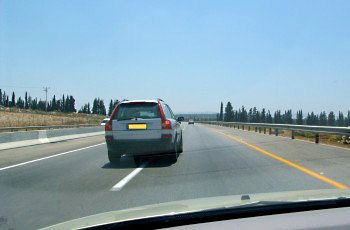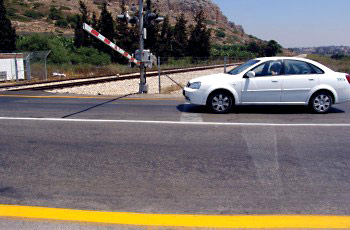Question:1
According to the law, in what order should vehicles enter the following intersection?

Category : Rules and Regulations
Question:2
What is the legal definition of “lighting up time”
Category : Rules and Regulations
Question:3
When are you obliged to signal before moving out of your lane for the purpose of overtaking?
Category : Rules and Regulations
Question:4
What should we do when driving behind a vehicle that is giving a direction indicator signal?
Category : Rules and Regulations
Question:5
What does the law state regarding the placing or leaving of objects on a road?
Category : Rules and Regulations
Question:6
Is the Licensing Authority allowed to revoke or suspend an existing driver’s license?
Category : Rules and Regulations
Question:7
When driving behind a slow vehicle on a roadway while a continuous centre white line is marked to your left:
Category : Rules and Regulations
Question:8
When are you obliged to stop before a railway crossing?
Category : Rules and Regulations
Question:9
Which vehicles are required to be equipped with a reflective traffic vest?
Category : Rules and Regulations
Question:10
Where inside a vehicle should the reflective traffic vest be placed?
Category : Rules and Regulations
Question:11
Define “one way street”
Category : Rules and Regulations
Question:12
A policeman has stopped a driver on the road.and demanded of him to take a breathyalyzer tests . Is the driver obliged to perform the test
Category : Rules and Regulations
Question:13
What is the minimum age requirement for carrying another passenger on a motorcycle?
Category : Rules and Regulations
Question:14
Under which conditions is a vehicle allowed to deviate from its line of driving?

Category : Rules and Regulations
Question:15
The boundary of the intersection / junction is determined by:
Category : Rules and Regulations
Question:16
It is prohibited to make a U-turn:
Category : Rules and Regulations
Question:17
On a narrow two-way road with an unbroken separation line dividing the two lanes, how would you conduct yourself when a horse drawn wagon drives before you and the opposite traffic lane is open?
Category : Rules and Regulations
Question:18
A policeman may stop a vehicle and have it checked:
Category : Rules and Regulations
Question:19
Under what conditions will the Licensing Authority approve change of ownership of a vehicle?
Category : Rules and Regulations
Question:20
A paraplegic is driving it the city and is in a hurry to a scheduled medical examination :
Category : Rules and Regulations
Question:21
How should those involved in a road accident, which resulted in property damage only, conduct themselves?
Category : Rules and Regulations
Question:22
The correctional measures which may be imposed by the Licensing Authority, based on the point system:
Category : Rules and Regulations
Question:23
When is it permitted to use the horn for giving a warning signal in an urban road?
Category : Rules and Regulations
Question:24
Who is legally responsible for the registration of a change of ownership?
Category : Rules and Regulations
Question:25
Is it permitted to drive through a railway crossing when the barrier is moving downwards or upwards?

Category : Rules and Regulations
Question:26
What does the law state about the non-use of a vehicle for a period of more than one month?
Category : Rules and Regulations
Question:27
“restricted (Calm) zone” is a zone:
Category : Rules and Regulations
Question:28
Is it permitted to drive a passenger on a motorcycle while both his legs are on one side of the motorcycle?
Category : Rules and Regulations
Question:29
Is it permitted to drive under the influence of sedatives?
Category : Rules and Regulations
Question:30
How would you conduct yourself when your motorcycle’s low beam malfunctions during a night drive?
Category : Rules and Regulations

